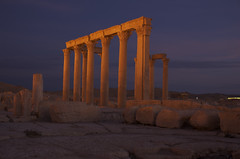About a year ago, the Bank of England introduced new coins. They didn't change the shape or material of the old ones, and their reverse faces would still show the inevitable portrait of our beloved Queen, but the front was redesigned. A Welshman won the competition. His idea was to transmogrify the five pence coins (one, two, five, ten, fifty) into a puzzle. Each would show a pattern with no obvious meaning. Put together the right way, with the five-pence piece, the smallest of the lot, at the center and the rest arranged around them, they would show the shield of the Royal Coat of Arms, which was also reproduced in full on the one-pound coin.
It is debatable if the new coins were a smart move. At the ballistic rate of decay of the value of Sterling, it seems like a waste of money to invest anything into this currency. Much cheaper would have been to adopt the euro. Just slap the new designs on coins already in existence millionfold all over Europe. No math will be necessary once parity is reached, which can only be a few short weeks away, and the presently mighty euro would cushion any further drop in the value of the pound.
No matter the advantages – imagined, as above, or real – the English are not going to accept the euro anytime soon. The wounded pride of a fallen empire takes generations to heal. What that means, though, is that we now have the new pound coins circulating. It took quite a while after the official announcement until I found the first specimen in my wallet, a penny that promptly infected me with the collection virus. Who is going to be the first to have them all?
The little pieces, two and five pence worth, followed in quick succession. Then the ten-pence disk, much larger than the others, arrived and the seven-pointed twenty. Arranging them on my desk, I could already imagine the final image, the coat of arms. At this point I was happily giving away duplicates to friends who had also caught the virus, but the fifty pee was hard to come by. I finally received it as a gift the day before I left for Christmas. I hadn't collected all pieces, but the puzzle was complete.
Yesterday I went to Nottingham for a conference. The city is well known for its resident rebel and charity spreader, Robin Hood. I expected to see history exploited touristically and was somewhat disappointed when all I saw on the way downtown from the station were shops. The central pedestrian precinct is one of the blandest and least appealing I have seen in a while. I wandered around for a while without finding anything interesting, had a coffee and made my way to the university, a bit out of town, where the conference was being held.
Later that night, a group of us went back to town for dinner and a few beers afterwards. It was then that history, elusive earlier in the day because I hadn't read a guide before coming, manifested itself. A huge and strongly fortified castle loomed up against the darkness as we walked to a pub advertising itself as the oldest in England. First mentioned in 1189, it got its name, Ye Olde Trip to Jerusalem, from an ambitious but short-lived attempt by Richard III to join the crusaders on their bloody journey to the Holy Land.
The pub is set against the walls of the castle. Some of its rooms are technically caves because they have been dug into the rock on which the castle stands. The spotlessly restored building shows its age with pride on the outside and is appropriately funky and eclectically decorated inside. I paid for my beer with a ten-pound note and was returned a handful of sparkling metal. Looking into my open hand, I counted six new pound coins. After scrounging so long for the piece to complete my collection, it was positively anti-climactic to find half a dozen at once.

No comments:
Post a Comment